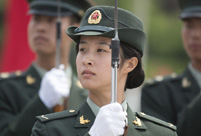 Chinese Kung Fu charms Silicon Valley
Chinese Kung Fu charms Silicon Valley
 Tranquil Yankou ancient town
Tranquil Yankou ancient town
 Lake Geneva: A show of swans
Lake Geneva: A show of swans
 Beautiful sunset over the Irtysh River
Beautiful sunset over the Irtysh River
 Qingjing Mosque: Witness of the ancient Maritime Silk Road
Qingjing Mosque: Witness of the ancient Maritime Silk Road
 Neiliansheng – more than 100 years of fashion
Neiliansheng – more than 100 years of fashion
 Golden retriever feeds baby African lions
Golden retriever feeds baby African lions
 Strange rocks in Lama Mountain
Strange rocks in Lama Mountain
 First overseas "China-standard" electric railway laid
First overseas "China-standard" electric railway laid
 College graduate launches organic agricultural cooperative in hometown
College graduate launches organic agricultural cooperative in hometownBEIJING, May 23 -- When one side of the earth is lit by the sun, the other side is in dark. This highlights the importance of joint efforts in developing solar energy.
But worldwide efforts have often met challenges, as in the latest anti-dumping and anti-subsidy investigations launched by the United States against China's photovoltaic (PV) products.
China's PV industry issued a statement on Wednesday, opposing the second investigation in three years by the United States, several days ahead of the release of the U.S. preliminary investigation results.
The United States initiated the investigations in February, the second after a similar one in 2011, which slowed the Chinese PV industry and damaged the development of the U.S. PV application market.
This time, the preliminary anti-subsidy investigation result is expected on June 2 and the preliminary anti-dumping investigation findings on July 28.
A large amount of hard evidence presented by the Chinese companies during the last investigation has already proved that there are no such things as dumping or illegal subsidies.
Chinese PV products win the affection of the world based on superior quality, reasonable prices and good after sales services, rather than taking advantage of any government subsidies.
It is a great pity the evidence was ignored by the U.S. side.
The protectionism measures of the U.S. side will not only hurt Chinese exporters, but also domestic market players and American people due to higher prices they would have to pay.
If the punitive duties were imposed, large PV power plants in the United States would be devastated by soaring costs and the nationwide application of clean energy would lose momentum for further expansion, which will in turn drag down economic growth and employment.
That is why the U.S. Solar Energy Industries Association have expressed opposition to the trade conflict.
As China's PV exports to the United States and EU declined over the past years, its shipments to Japan and emerging markets like India and South Africa rose. Asian buyers absorbed more than half of China's exports in the first quarter, as compared to less than 20 percent for the EU market.
This in a way indicates that many more countries have become interested in the clean energy source as its cost declines steadily.
As the world PV production center shifts to Asian countries like China, the worldwide process of technology transfer and clean energy development is accelerated. This is important to the overall development of the global PV sector.
China and the United States should seek proper settlements of trade disputes with full consideration of the mutually beneficial situation for PV industry growth.
Negotiation is the best resort to bridge the difference and create a win-win situation, as proven by the successful settlement of a similar case between China and the EU a year ago.
A tit-for-tat approach always hurts. The two sides should endeavor to exclude this option from their arsenals with views to create a favorable situation for global growth.
 Opening ceremony of 67th Cannes Film Festival
Opening ceremony of 67th Cannes Film Festival Pulse of Xiamen - Int'l Yoga art festival in May
Pulse of Xiamen - Int'l Yoga art festival in May Photo story: Life of a scrap metal recycle worker
Photo story: Life of a scrap metal recycle worker Training of the PLA's first female honor guard
Training of the PLA's first female honor guard China's 10 must-see animations
China's 10 must-see animations Female bodybuilders show their beauty of fitness
Female bodybuilders show their beauty of fitness A taste of Harbin cuisine
A taste of Harbin cuisine A bite of Jiang Nan
A bite of Jiang Nan Who is China's campus beauty queen?
Who is China's campus beauty queen? 8 great movies to watch with your mom
8 great movies to watch with your mom China's most luminous celebrities
China's most luminous celebrities Newly recruited police in Hetian hold drill
Newly recruited police in Hetian hold drill  Bird-men compete flying in Hong Kong
Bird-men compete flying in Hong Kong  The 'Chinese Dad'
The 'Chinese Dad' Shanghai locals bid farewell to childhood memories
Shanghai locals bid farewell to childhood memoriesDay|Week|Month